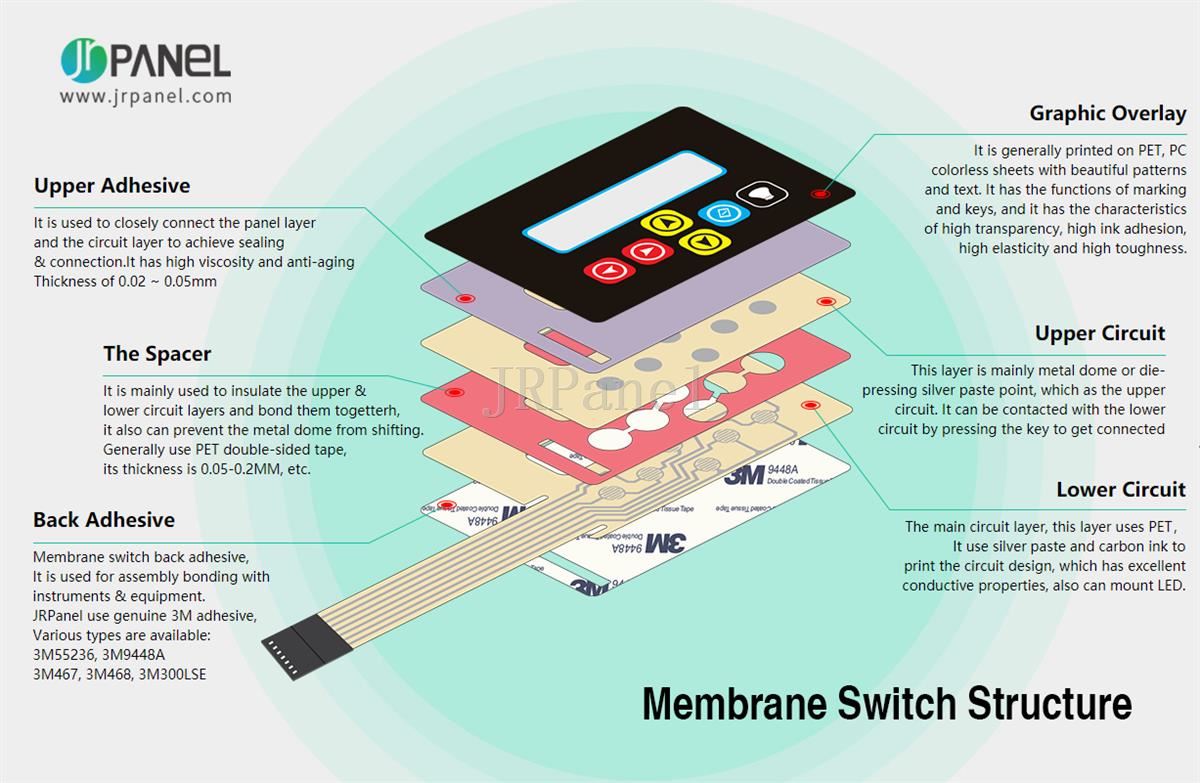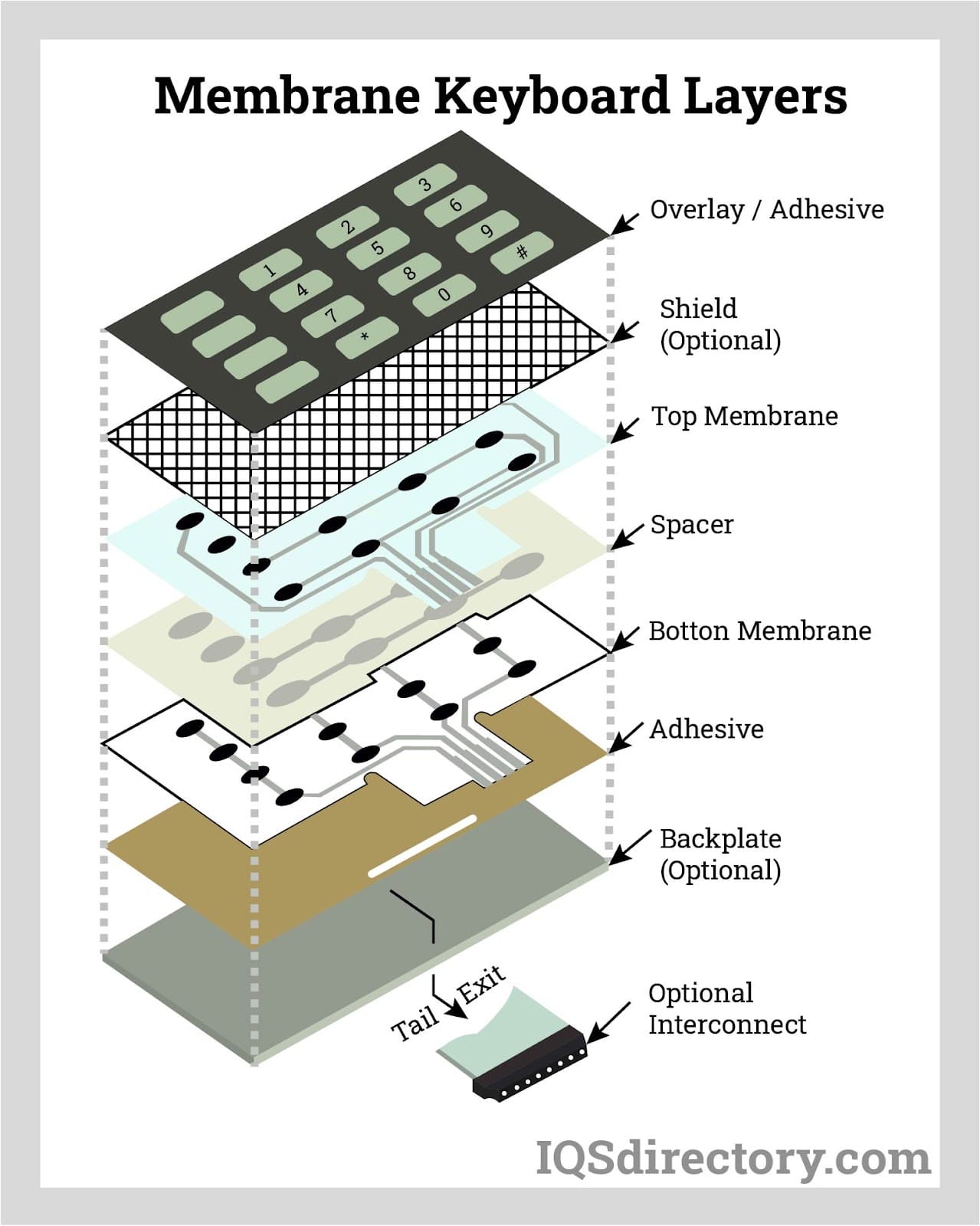All Concerning Membrane layer Switch Over: A Comprehensive Guide for Beginners
Membrane layer switches are important parts in modern electronic devices, supplying a distinct user interface for user communication - membrane switch. Their layered construction, consisting of overlays and conductive traces, provides performance and durability. Unlike traditional mechanical switches, membrane buttons provide a smooth design and adjustable options. Recognizing their essential functions and advantages can transform product layout. Nevertheless, the complexities of their application and style factors to consider require further expedition
What Is a Membrane Switch?
A membrane layer switch is a type of electrical switch that consists of a versatile membrane layer layered over a published circuit board. This style enables a compact and sleek interface, typically made use of in numerous electronic devices. Membrane buttons are frequently discovered in consumer home appliances, medical equipment, and commercial machinery due to their durability and resistance to environmental factors.The building and construction commonly includes numerous layers, such as visuals overlays and sticky backing, which supply responsive comments and secure the wiring beneath. The procedure of a membrane layer switch is initiated when pressure is put on the surface, completing an electrical circuit.These switches are valued for their convenience, making it possible for custom-made styles and printed graphics that provide to details customer interfaces. Their inconspicuous nature reduces area demands, making them optimal for applications where traditional buttons might not fit. On the whole, membrane layer switches provide a practical and aesthetic solution for contemporary digital gadgets.
Key Parts of Membrane Switches
Membrane switches over comprise a number of key parts that add to their performance and efficiency. The leading layer, known as the overlay, provides the interface and is usually published with graphics or symbols. Under the overlay lies a spacer layer, which divides the conductive components and avoids unintended activation. The following essential component is the graphic layer, which boosts aesthetics and ensures the longevity of the design.Conductive traces, generally made from products like silver or carbon, are published on the circuit layer. When pressure is related to the overlay, these traces enter contact, finishing the circuit. Furthermore, a backing layer uses architectural support and can be made from products such as polyester or polycarbonate. Together, these parts produce a reliable, easy to use interface appropriate for various applications, from family devices to commercial equipment. Recognizing these components is necessary for anybody interested in membrane switch technology.
Exactly How Membrane Switches Work
Understanding how membrane layer switches over feature is necessary for appreciating their extensive use in numerous tools. A membrane layer switch operates via a collection of layers, consisting of a graphic overlay, spacer, and a circuit layer. When stress is related to the overlay, it presses the spacer layer, allowing the circuit layer to make contact and complete an electrical circuit. This action sends a signal to the gadget, motivating a response, such as transforming on a light or triggering a function.Membrane switches over can be made with various functions, including tactile feedback, backlighting, and custom graphics, boosting individual communication. Their construction enables for a covered layout, shielding the internal components from dust, dampness, and impurities. This resilience makes them suitable for diverse applications, from customer electronic devices to industrial equipment. In general, the simplicity and efficiency of membrane switches over contribute to their popularity in modern-day technology.
Advantages of Membrane Switches Over Over Mechanical Buttons
While mechanical switches have actually long been a staple in numerous gadgets, membrane layer switches over deal unique advantages that make them progressively appealing. One substantial advantage is their slim account, enabling for even more portable styles and better flexibility in item development. Furthermore, membrane switches function an uniform surface area, which enhances visual allure and streamlines cleansing, making them appropriate for atmospheres where hygiene is critical.Another benefit is their resistance to dirt and moisture. Unlike mechanical buttons, which can be compromised by environmental variables, membrane layer switches offer a sealed interface that protects versus contaminants - membrane switch. In addition, membrane important link layer switches usually have a longer lifespan because of fewer relocating components, leading to enhanced longevity and reliability.Cost-effectiveness is additionally a significant advantage, as membrane layer switches can be produced wholesale with reduced manufacturing expenses. These elements combine to position membrane layer buttons as a practical option to typical mechanical choices in various applications
Common Applications of Membrane Switches
Membrane layer switches are commonly utilized in different sectors, specifically in customer electronic devices and commercial control board. In consumer devices, they supply a streamlined, straightforward interface, while in commercial settings, they enhance toughness and performance. Understanding these applications highlights the adaptability and functionality of membrane switches in contemporary innovation.
Customer Electronic Devices Instruments
As customer electronic devices remain to advance, membrane buttons have actually come to be a prominent choice for a range of devices due to their adaptability and smooth style. These buttons are commonly discovered in smartphones, tablets, and remote controls, where room is minimal and appearances matter. Their low profile and personalized designs allow manufacturers to develop straightforward interfaces that enhance the total customer experience. Furthermore, membrane buttons are commonly utilized in appliances such as microwaves and coffee machine, giving user-friendly control options while resisting moisture and dust. The longevity and reliability of membrane layer switches make them appropriate for daily customer products, ensuring durability and constant efficiency. On the whole, their integration in consumer electronics mirrors a mix of performance and modern-day layout.
Industrial Control Panels
The applications of membrane layer switches prolong beyond consumer electronic devices, locating substantial use in commercial control board. These switches are preferred for their sturdiness and resistance to extreme environments, making them excellent for manufacturing and procedure control settings. They offer a More hints trustworthy user interface for drivers to control equipment, screen procedures, and change settings. Membrane layer switches can be tailored to fit particular functional needs, integrating functions like backlighting and responsive feedback, improving individual experience. Their low-profile design permits for assimilation right into different devices, while their capability to stand up to spills, dust, and severe temperatures guarantees longevity. On the whole, membrane layer buttons add to secure and effective procedure in industrial applications, demonstrating their convenience and efficiency sought after atmospheres.
Factors To Consider for Designing Membrane Changes
When creating membrane buttons, picking the ideal products is vital to assure longevity and performance. In addition, recognizing layer configuration methods can considerably affect the switch's efficiency and individual experience. These factors to consider play an important role in producing effective and trustworthy membrane layer switch layouts.
Product Choice Relevance
Material option plays a necessary duty in the style and performance of membrane switches. The chosen products straight influence the button's sturdiness, tactile feedback, and total visual. Trick factors to consider include the substrate, which must provide structural honesty while permitting adaptability, and the graphic overlay, which needs to be immune to wear and ecological aspects. Conductive materials should guarantee reliable electrical performance, while adhesives have to provide solid bonding without compromising the switch's operation. Furthermore, compatibility with manufacturing processes and end-user environments is important; materials have to stand up to varying temperatures, moisture degrees, and chemical direct exposure. Inevitably, ideal material option not just improves the membrane button's efficiency but likewise adds to its long life and customer contentment, making it a crucial aspect of the style procedure.

Layer Configuration Strategies

Often Asked Concerns
For How Long Do Membrane Changes Typically Last?
Membrane layer switches generally have a lifespan of 1 to 5 million cycles, relying on use and environmental problems. Variables such as style high quality and operating regularity significantly influence their durability and general performance longevity.

Can Membrane Layer Changes Be Customized for Certain Designs?
Membrane layer buttons can undoubtedly be tailored to suit details designs, permitting for diverse forms, colors, and capabilities. This adaptability makes it possible for manufacturers to tailor these buttons to satisfy distinct aesthetic and operational needs effectively.
What Materials Are Used in Membrane Layer Change Building And Construction?
Membrane buttons are normally built using materials such as polyester, polycarbonate, and glue layers. These products offer resistance, adaptability, and sturdiness to ecological elements, making sure the switches operate properly in numerous applications and problems.
Are Membrane Layer Switches Over Resistant or water-proof to Dampness?
Membrane buttons can be developed to be moisture-resistant, utilizing specialized products and coverings. Their waterproof abilities depend on building and construction top quality and particular applications, making it crucial to analyze demands for suitable efficiency in various atmospheres.
Just How Are Membrane Changes Fixed if Damaged?
Fixing damaged membrane layer switches over normally entails replacing the affected layer or circuit. Professionals might additionally use conductive sticky or make use of specialized repair service kits, making sure functionality is restored without complete replacement of the entire button setting up. Unlike standard mechanical buttons, membrane switches offer a sleek layout and personalized choices. A membrane layer switch is a type of electrical button that consists of a flexible membrane layered over a printed circuit board. The operation of a membrane layer button is initiated when pressure is used to the surface area, finishing an electrical circuit.These switches are valued for their flexibility, allowing customized designs and printed graphics that provide to specific user interfaces. While mechanical buttons have actually long been a staple in several tools, membrane switches deal unique benefits that make them increasingly appealing. Membrane switches typically have a longer life expectancy due to less moving components, resulting in boosted sturdiness and reliability.Cost-effectiveness is likewise a noteworthy advantage, as membrane layer buttons can be created in bulk with reduced manufacturing costs.